radiator MERCEDES-BENZ R-CLASS FAMILY TOURER 2013 Owners Manual
[x] Cancel search | Manufacturer: MERCEDES-BENZ, Model Year: 2013, Model line: R-CLASS FAMILY TOURER, Model: MERCEDES-BENZ R-CLASS FAMILY TOURER 2013Pages: 364, PDF Size: 28.68 MB
Page 13 of 364
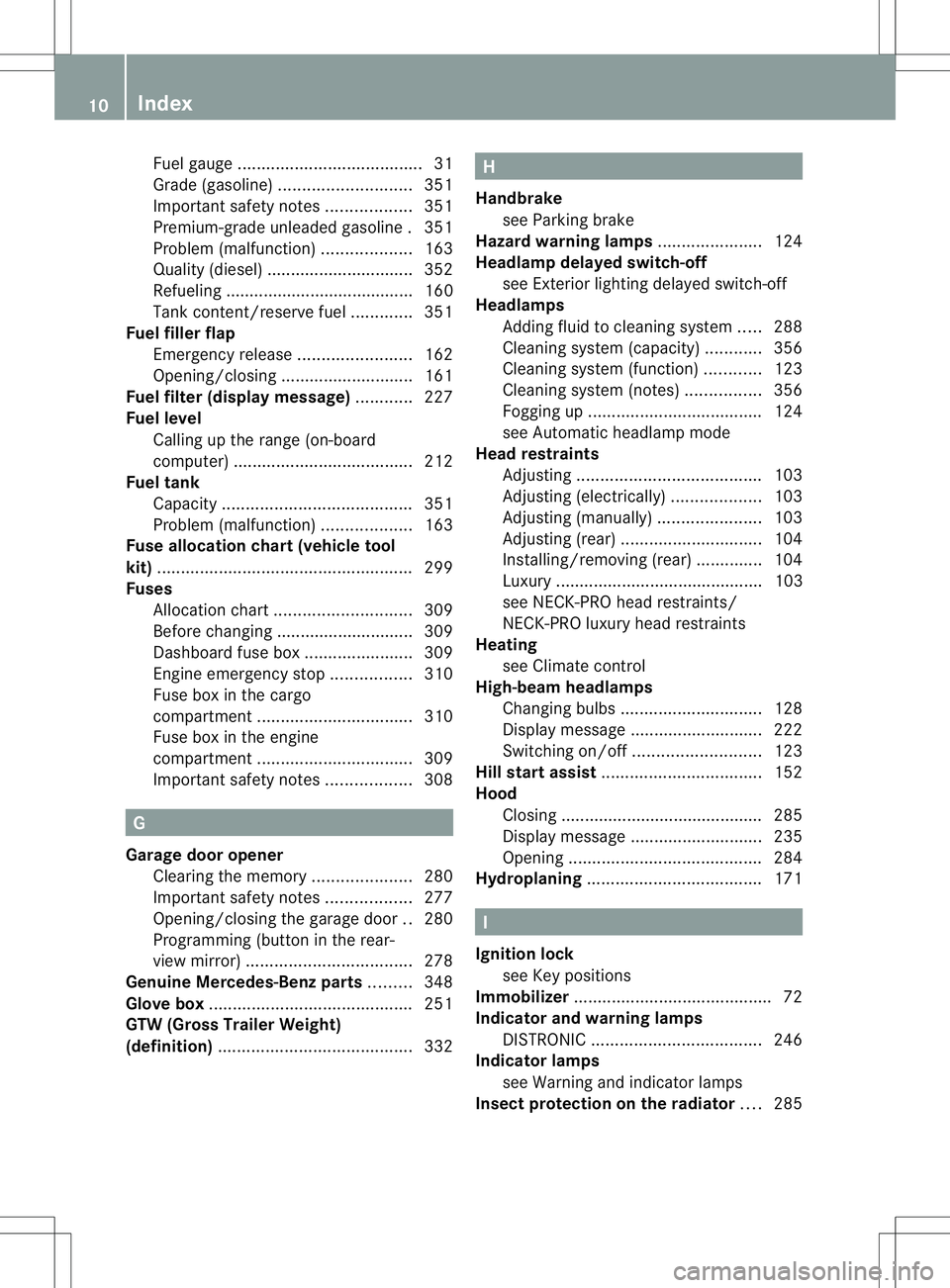
Fue
lgauge ....................................... 31
Grade (gasoline) ............................ 351
Important safety notes ..................351
Premium-grade unleaded gasoline .351
Problem (malfunction) ...................163
Quality (diesel). .............................. 352
Refueling ........................................ 160
Tank content/reserve fuel .............351
Fuel filler flap
Emergency release ........................162
Opening/closing ............................ 161
Fuel filte r(display message) ............227
Fuel level Calling up the range (on-board
computer) ...................................... 212
Fuel tank
Capacity ........................................ 351
Problem (malfunction) ...................163
Fuse allocation chart (vehicle tool
kit) ...................................................... 299
Fuses Allocation chart ............................. 309
Before changing ............................. 309
Dashboard fuse box .......................309
Engine emergency stop .................310
Fuse box in the cargo
compartment ................................. 310
Fuse box in the engine
compartment ................................. 309
Important safety notes ..................308 G
Garage door opener Clearing the memory .....................280
Important safety notes ..................277
Opening/closing the garage door ..280
Programming (button in the rear-
view mirror) ................................... 278
Genuine Mercedes-Benz parts .........348
Glove box ........................................... 251
GTW (Gross Trailer Weight)
(definition) ......................................... 332 H
Handbrake see Parking brake
Hazard warning lamps ......................124
Headlamp delayed switch-off see Exterior lighting delayed switch-off
Headlamps
Adding fluid to cleaning system .....288
Cleaning system (capacity )............ 356
Cleaning system (function) ............123
Cleaning system (notes) ................356
Fogging up ..................................... 124
see Automatic headlamp mode
Head restraints
Adjusting ....................................... 103
Adjusting (electrically). ..................103
Adjusting (manually). .....................103
Adjusting (rear) .............................. 104
Installing/removing (rear) ..............104
Luxury ............................................ 103
see NECK-PRO head restraints/
NECK-PRO luxury head restraints
Heating
see Climate control
High-beam headlamps
Changing bulbs .............................. 128
Display message ............................ 222
Switching on/off ........................... 123
Hill start assist .................................. 152
Hood Closing .......................................... .285
Display message ............................ 235
Opening ......................................... 284
Hydroplaning ..................................... 171 I
Ignition lock see Key positions
Immobilizer .......................................... 72
Indicator and warning lamps DISTRONI C.................................... 246
Indicator lamps
see Warning and indicator lamps
Insectp rotection on the radiator ....285 10
Index
Page 17 of 364
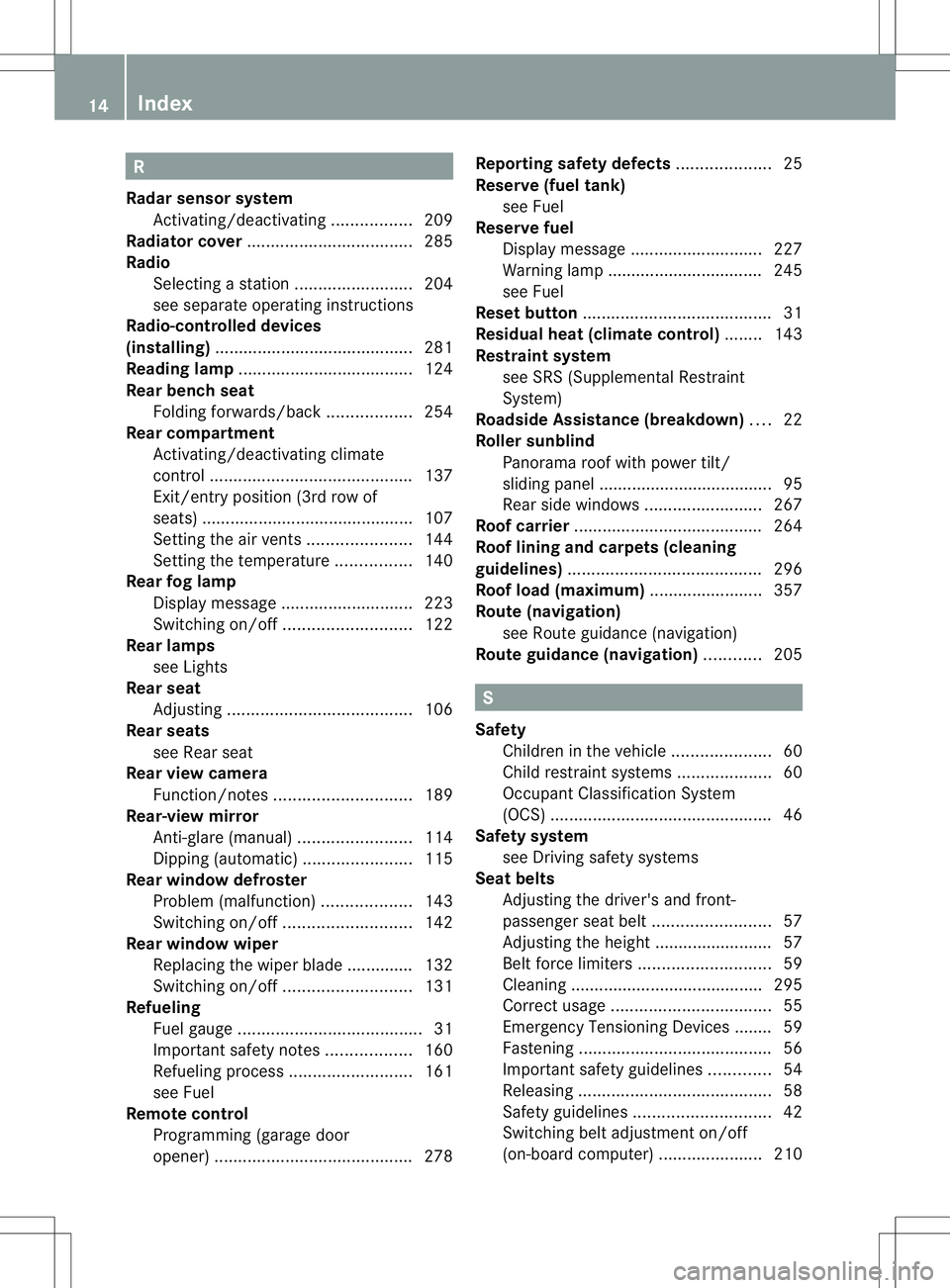
R
Radar sensor system Activating/deactivating .................209
Radiator cover ................................... 285
Radio Selecting astation ......................... 204
see separate operating instructions
Radio-controlled devices
(installing) .......................................... 281
Reading lamp ..................................... 124
Rear bench seat Folding forwards/back ..................254
Rear compartment
Activating/deactivating climate
control ........................................... 137
Exit/entry position (3rd row of
seats) ............................................ .107
Setting the airv ents...................... 144
Setting the temperature ................140
Rear fog lamp
Display message ............................ 223
Switching on/off ........................... 122
Rear lamps
see Lights
Rear seat
Adjusting ....................................... 106
Rear seats
see Rears eat
Rear view camera
Function/notes ............................. 189
Rear-view mirror
Anti-glare (manual). .......................114
Dipping (automatic) .......................115
Rear window defroster
Problem (malfunction) ...................143
Switching on/off ........................... 142
Rear window wiper
Replacing the wiper blade .............. 132
Switching on/off ........................... 131
Refueling
Fuel gauge ....................................... 31
Important safety notes ..................160
Refueling process. .........................161
see Fuel
Remote control
Programming (garage door
opener) .......................................... 278Reporting safety defects
....................25
Reserve (fuel tank) see Fuel
Reserve fuel
Display message ............................ 227
Warning lamp ................................. 245
see Fuel
Reset button ........................................ 31
Residual heat (climate control) ........143
Restraint system see SRS (Supplemental Restraint
System)
Roadside Assistance (breakdown) ....22
Roller sunblind Panorama roof with power tilt/
sliding panel ..................................... 95
Rea rside windows ......................... 267
Roof carrier ........................................ 264
Roof lining and carpets (cleaning
guidelines) ......................................... 296
Roof load (maximum) ........................357
Route (navigation) see Route guidance (navigation)
Route guidance (navigation) ............205 S
Safety Childrenint he vehicle..................... 60
Child restraint systems ....................60
Occupant Classification System
(OCS) ............................................... 46
Safety system
see Driving safety systems
Seat belts
Adjusting the driver's and front-
passenger seatb elt......................... 57
Adjusting the height ......................... 57
Belt force limiters ............................ 59
Cleaning ......................................... 295
Correct usage .................................. 55
Emergency Tensioning Devices ....... .59
Fastening ......................................... 56
Important safety guidelines .............54
Releasing ......................................... 58
Safety guidelines ............................. 42
Switching belt adjustment on/off
(on-board computer) ......................21014
Index
Page 22 of 364
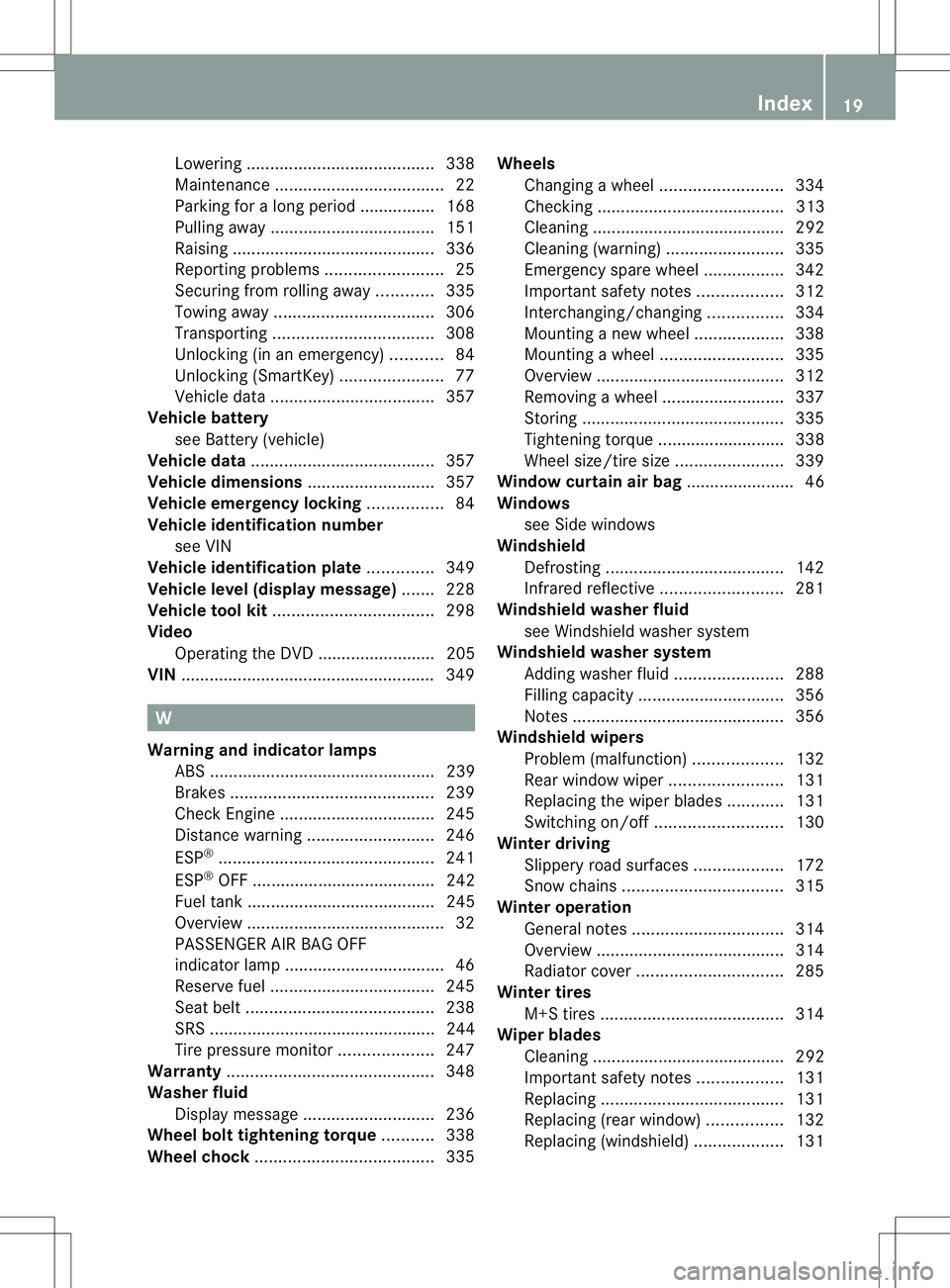
Lowering
........................................ 338
Maintenance .................................... 22
Parking for a long period ................ 168
Pulling away ................................... 151
Raising ........................................... 336
Reporting problems .........................25
Securing from rolling away ............335
Towing away .................................. 306
Transporting .................................. 308
Unlocking (in an emergency) ...........84
Unlocking (SmartKey) ......................77
Vehicle data ................................... 357
Vehicle battery
see Battery (vehicle)
Vehicle data ....................................... 357
Vehicle dimensions ...........................357
Vehicle emergency locking ................84
Vehicle identification number see VIN
Vehicle identification plate ..............349
Vehicle level (display message) .......228
Vehicle tool kit .................................. 298
Video Operating the DVD ......................... 205
VIN ...................................................... 349W
Warning and indicator lamps ABS ................................................ 239
Brakes ........................................... 239
Check Engine ................................. 245
Distance warning ........................... 246
ESP ®
.............................................. 241
ESP ®
OFF ....................................... 242
Fuel tank ........................................ 245
Overview .......................................... 32
PASSENGER AIR BAG OFF
indicator lamp .................................. 46
Reserve fuel ................................... 245
Seat belt. ....................................... 238
SRS ................................................ 244
Tire pressure monitor ....................247
Warranty ............................................ 348
Washer fluid Display message ............................ 236
Wheel bol ttightening torque ...........338
Wheel chock ...................................... 335Wheels
Changing awheel .......................... 334
Checking ........................................ 313
Cleaning ......................................... 292
Cleaning (warning) .........................335
Emergency spare wheel .................342
Important safety notes ..................312
Interchanging/changing ................334
Mounting anew wheel ................... 338
Mounting awheel .......................... 335
Overview ........................................ 312
Removing awheel .......................... 337
Storing ........................................... 335
Tightening torque ........................... 338
Whee lsize/tir esize ....................... 339
Window curtain air bag ....................... 46
Windows see Side windows
Windshield
Defrosting ...................................... 142
Infrared reflective .......................... 281
Windshiel dwasher fluid
see Windshield washer system
Windshield washer system
Adding washer fluid .......................288
Filling capacity ............................... 356
Notes ............................................. 356
Windshiel dwipers
Problem (malfunction) ...................132
Rea rwindow wiper ........................ 131
Replacing the wiper blades ............131
Switching on/off ........................... 130
Winte rdriving
Slippery roa dsurface s................... 172
Snow chains .................................. 315
Winter operation
General notes ................................ 314
Overview ........................................ 314
Radiator cover ............................... 285
Winter tires
M+S tires ....................................... 314
Wiper blades
Cleaning ......................................... 292
Important safety notes ..................131
Replacing ....................................... 131
Replacing (rea rwindow) ................ 132
Replacing (windshield). ..................131 Index
19
Page 175 of 364
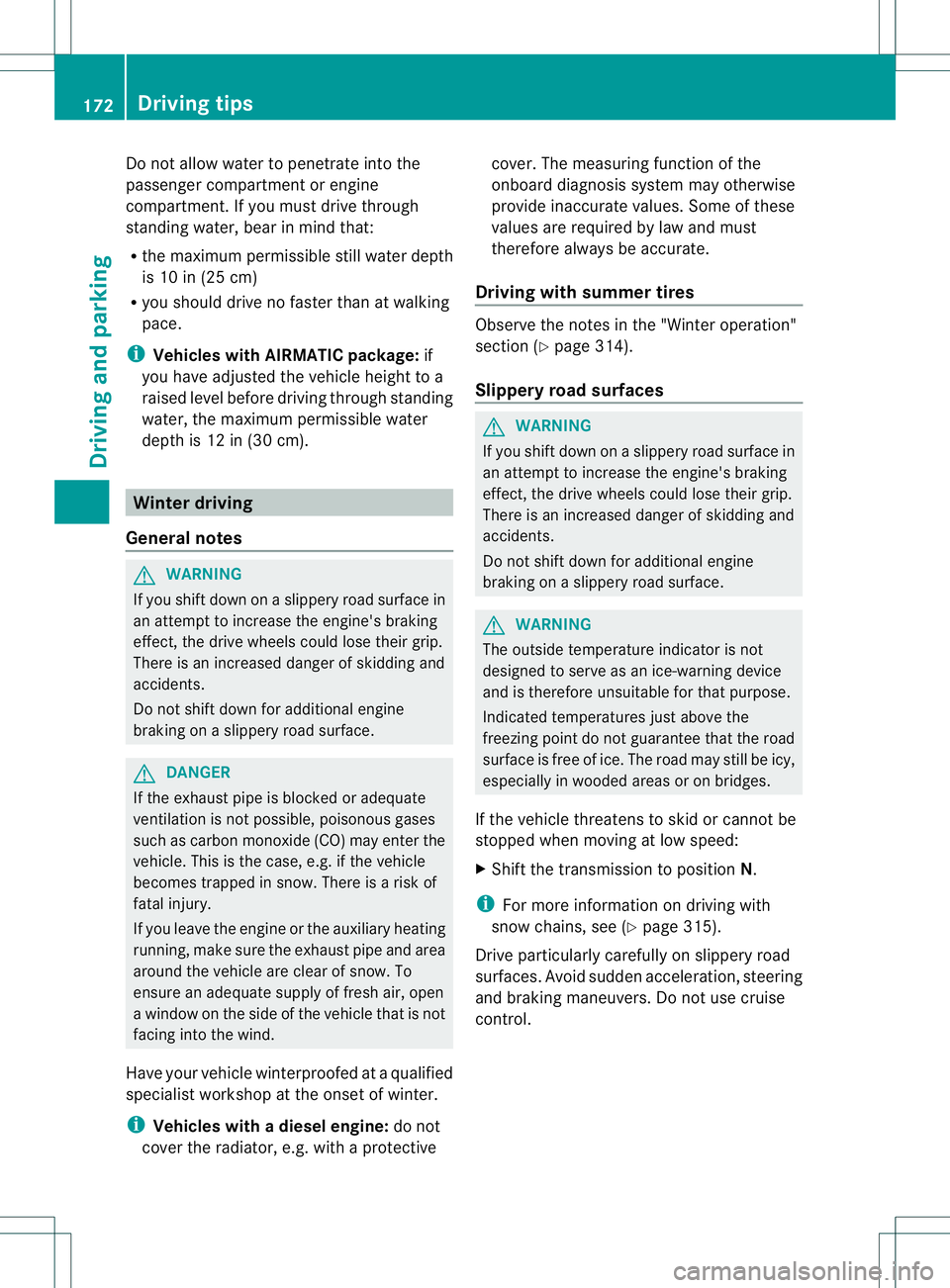
Do not allow water to penetrate into the
passenge
rcompartmen torengine
compartment. If you must drive through
standing water, bear in mind that:
R the maximu mpermissible still water depth
is 10 in (25 cm)
R you should drive no faster than at walking
pace.
i Vehicles with AIRMATIC package: if
you have adjusted the vehicle height to a
raised level before driving through standing
water, the maximum permissible water
depth is 12 in (30 cm). Winter driving
General notes G
WARNING
If you shift down on a slippery road surface in
an attempt to increase the engine's braking
effect, the drive wheels could lose their grip.
There is an increased danger of skidding and
accidents.
Do not shift down for additional engine
braking on a slippery road surface. G
DANGER
If the exhaust pipe is blocked or adequate
ventilation is not possible, poisonous gases
such as carbon monoxide (CO) may enter the
vehicle. This is the case, e.g. if the vehicle
becomes trapped in snow. There is a risk of
fatal injury.
If you leave the engineort he auxiliary heating
running, make sure the exhaust pipe and area
around the vehicle are clear of snow. To
ensure an adequate supply of fresh air, open
a window on the side of the vehicle that is not
facing into the wind.
Have your vehicle winterproofed at a qualified
specialist workshop at the onset of winter.
i Vehicles with adiesel engine: do not
cover the radiator, e.g. with a protective cover. The measuring function of the
onboard diagnosis syste
mmay otherwise
provide inaccurate values .Some of these
values are required by law and must
therefore always be accurate.
Driving with summer tires Observe the notes in the "Winter operation"
section (Y
page 314).
Slippery road surfaces G
WARNING
If you shift down on a slippery road surface in
an attempt to increase the engine's braking
effect, the drive wheels could lose their grip.
There is an increased danger of skidding and
accidents.
Do not shift down for additional engine
braking on a slippery road surface. G
WARNING
The outside temperature indicator is not
designed to serve as an ice-warning device
and is therefore unsuitable for that purpose.
Indicated temperatures just above the
freezing point do not guarantee that the road
surface is free of ice. The road may still be icy,
especially in wooded areas or on bridges.
If the vehicle threatens to skid or cannot be
stopped when moving at low speed:
X Shift the transmission to position N.
i For more information on driving with
snow chains, see (Y page 315).
Drive particularly carefully on slippery road
surfaces. Avoid sudden acceleration, steering
and braking maneuvers. Do not use cruise
control. 172
Driving tipsDriving and parking
Page 228 of 364
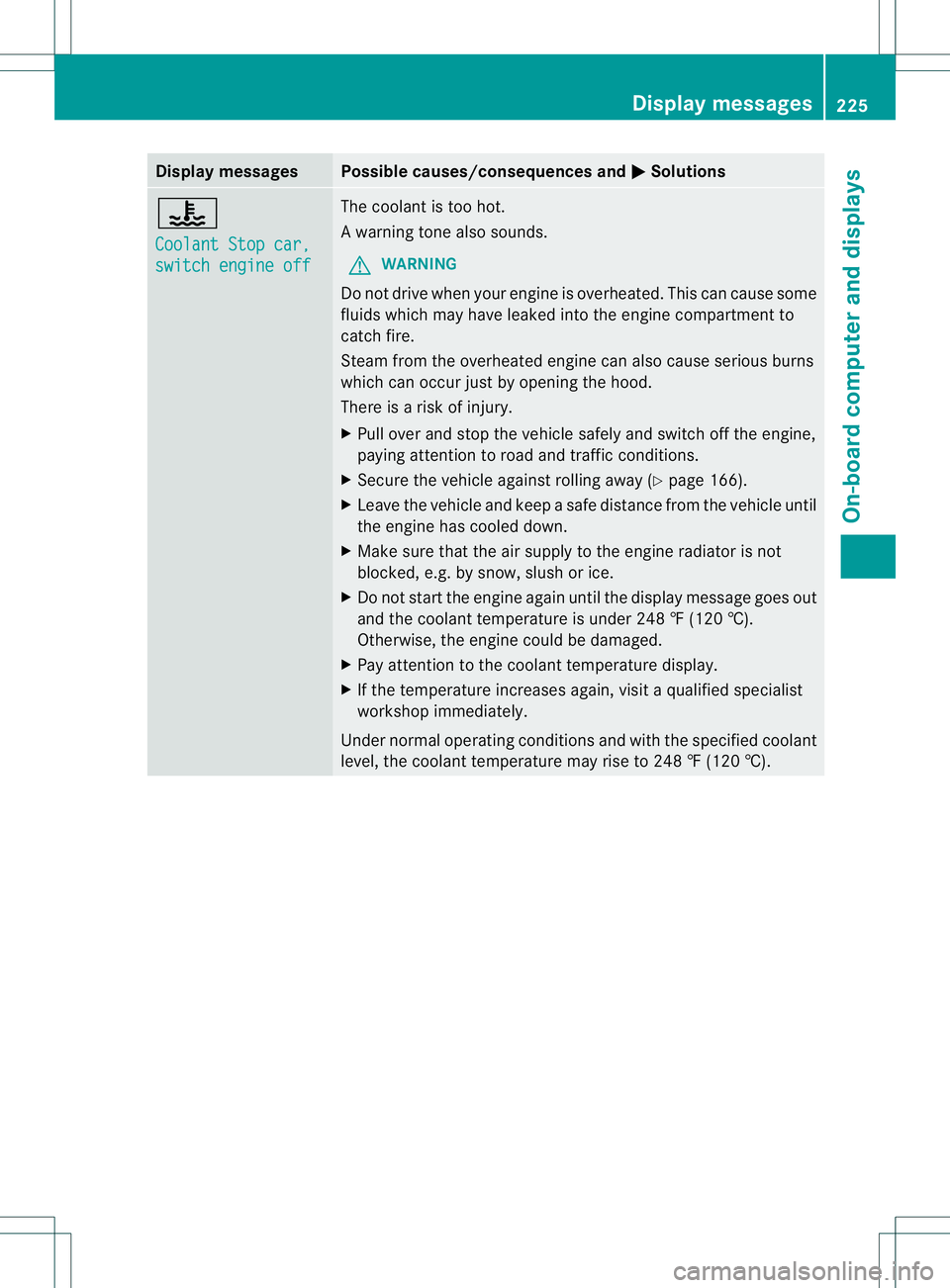
Display messages Possible causes/consequences and
M Solutions
?
Coolant Stop car,
switch engine off The coolan
tis too hot.
Aw arning tone also sounds.
G WARNING
Do no tdrive when youre ngine is overheated. Thi scan cause some
fluids which may have leaked into the engine compartmen tto
catch fire.
Stea mfrom the overheated engine can also cause serious burns
which can occur just by opening the hood.
There is a risk of injury.
X Pull over and stop the vehicle safely and switch off the engine,
paying attention to road and traffic conditions.
X Secure the vehicle against rolling away (Y page 166).
X Leave the vehicle and keep a safe distance from the vehicle until
the engine has cooled down.
X Make sure that the air supply to the engine radiator is not
blocked, e.g. by snow, slush or ice.
X Do not start the engine again until the display message goes out
and the coolant temperature is under 248 ‡ (120 †).
Otherwise, the engine could be damaged.
X Pay attention to the coolant temperature display.
X If the temperature increases again, visit a qualified specialist
workshop immediately.
Under normal operating conditions and with the specified coolant
level, the coolant temperature may rise to 248 ‡ (120 †). Display messages
225On-board computer and displays Z
Page 233 of 364
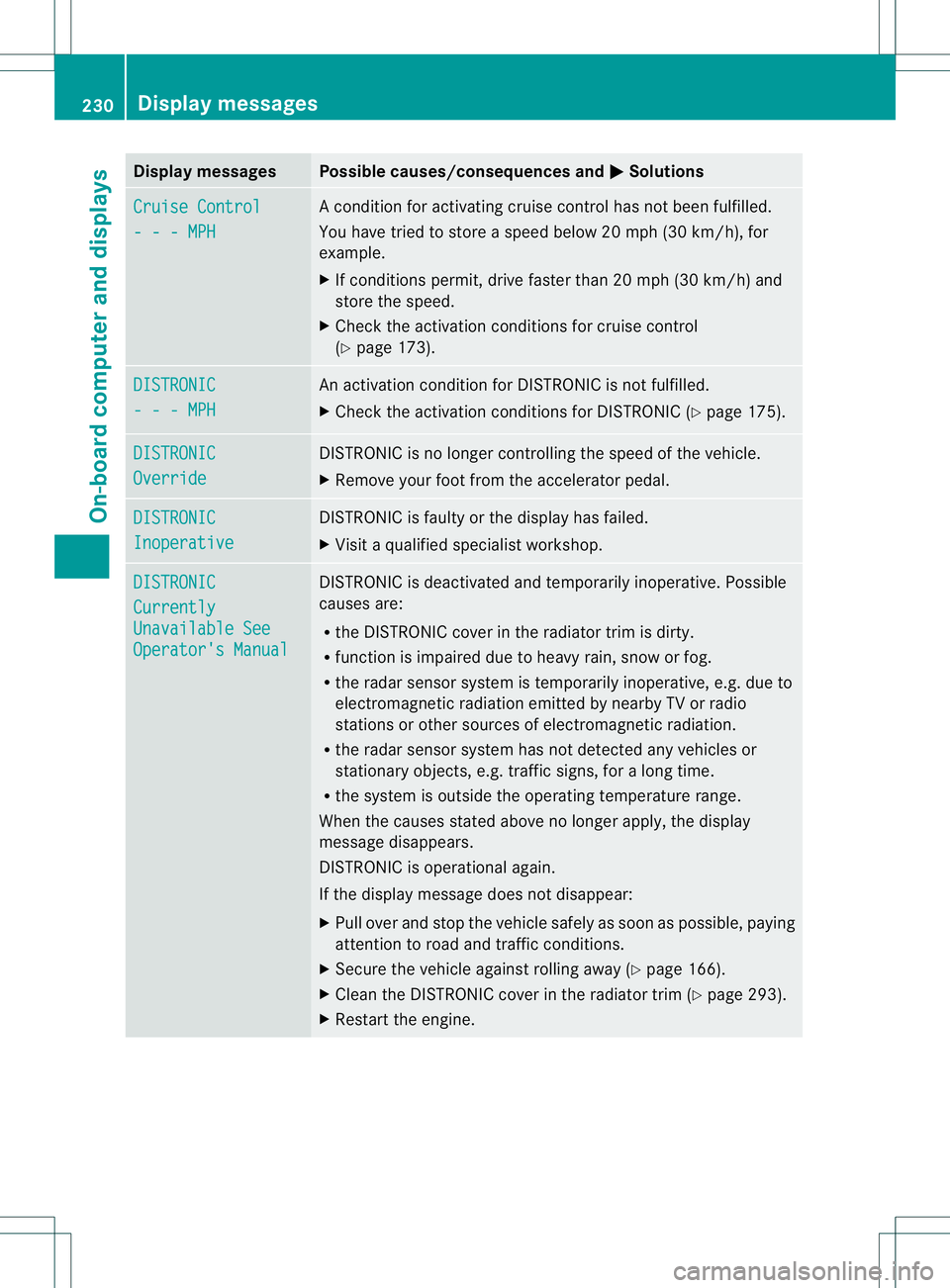
Display messages Possible causes/consequences and
M Solutions
Cruise Control
- - - MPH Ac
ondition for activating cruise control has not been fulfilled.
You have tried to store aspeed below 20 mph (30 km/h), for
example.
X If conditions permit, drive faster than 20 mph (30 km/h) and
store the speed.
X Check the activation conditions for cruise control
(Y page 173). DISTRONIC
- - - MPH An activation condition for DISTRONIC is not fulfilled.
X
Check the activation conditions for DISTRONIC (Y page 175).DISTRONIC
Override DISTRONIC is no longer controlling the speed of the vehicle.
X
Remove your foot from the accelerator pedal. DISTRONIC
Inoperative DISTRONIC is faulty or the display has failed.
X
Visit a qualified specialist workshop. DISTRONIC
Currently
Unavailable See
Operator's Manual DISTRONIC is deactivated and temporarily inoperative. Possible
causes are:
R
the DISTRONIC cover in the radiator trim is dirty.
R function is impaired due to heavy rain, snow or fog.
R the radar sensors ystem is temporarily inoperative, e.g. due to
electromagnetic radiation emitted by nearby TV or radio
stations or other sources of electromagnetic radiation.
R the rada rsensor system has not detected any vehicles or
stationary objects, e.g. traffic signs, for a long time.
R the system is outside the operating temperature range.
When the causes stated above no longer apply, the display
message disappears.
DISTRONIC is operational again.
If the display message does not disappear:
X Pull over and stop the vehicle safely as soon as possible, paying
attention to road and traffic conditions.
X Secure the vehicle against rolling away (Y page 166).
X Clean the DISTRONIC cover in the radiator trim (Y page 293).
X Restart the engine. 230
Display messagesOn-board computer and displays
Page 287 of 364
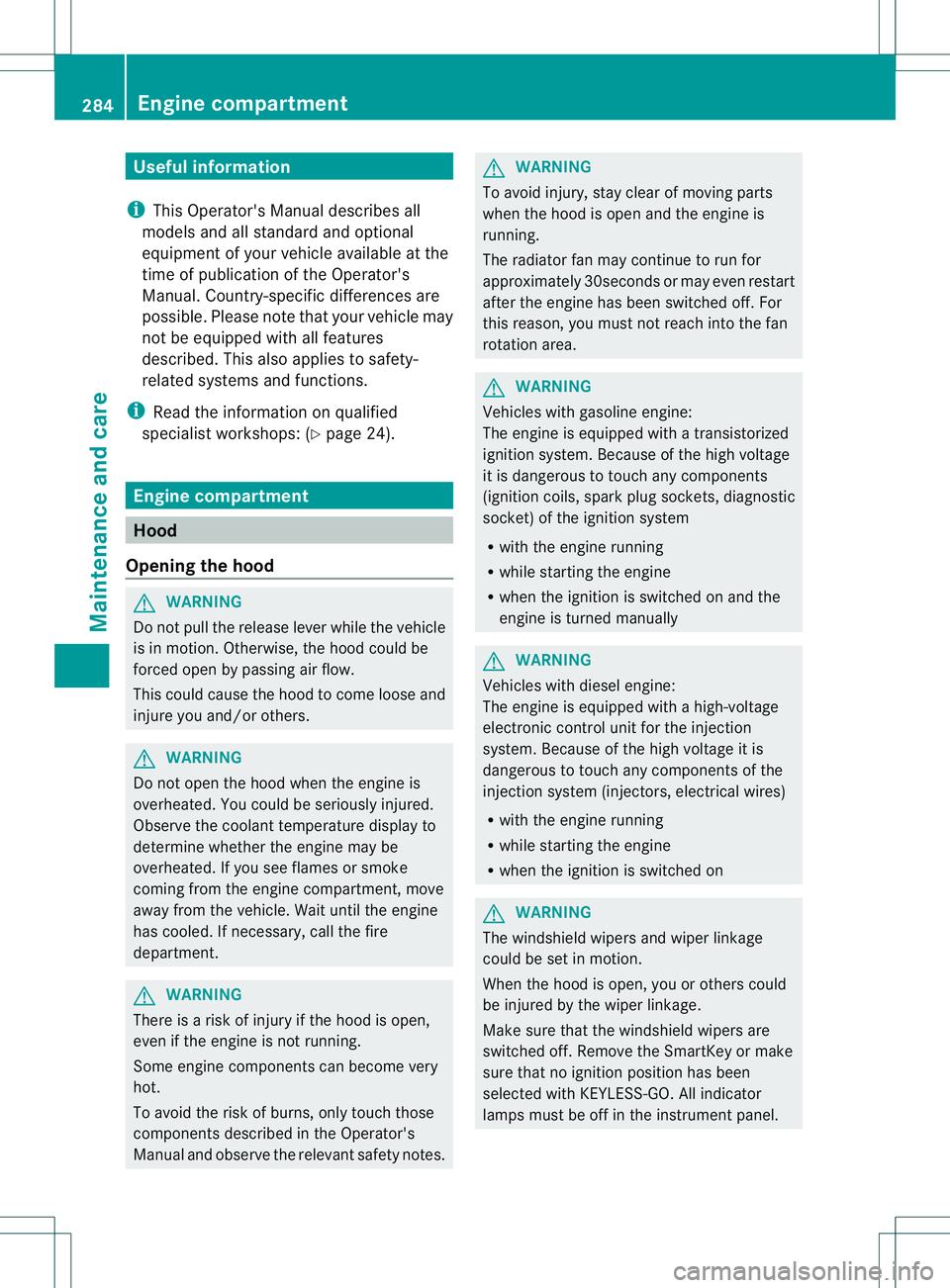
Useful information
i This Operator's Manual describes all
models and all standard and optional
equipment of your vehicle available at the
time of publication of the Operator's
Manual. Country-specific differences are
possible. Please note that your vehicle may
not be equipped with all features
described. This also applies to safety-
related systems and functions.
i Read the information on qualified
specialist workshops: (Y page 24).Engine compartment
Hood
Opening the hood G
WARNING
Do not pull the release lever while the vehicle
is in motion. Otherwise, the hood could be
forced open by passing air flow.
This could cause the hood to come loose and
injure you and/oro thers.G
WARNING
Do not open the hood when the engine is
overheated. You could be seriously injured.
Observe the coolant temperature display to
determine whether the engine may be
overheated. If you see flames or smoke
coming from the engine compartment, move
away fro mthe vehicle. Wait until the engine
has cooled. If necessary, call the fire
department. G
WARNING
There is a risk of injury if the hood is open,
even if the engine is not running.
Some engine components can become very
hot.
To avoid the risk of burns, only touch those
components described in the Operator's
Manual and observe the relevant safety notes. G
WARNING
To avoid injury, stay clear of moving parts
when the hood is open and the engine is
running.
The radiator fan may continue to run for
approximately 30seconds or may even restart
after the engine has been switched off. For
this reason, you must not reach into the fan
rotation area. G
WARNING
Vehicles with gasoline engine:
The engine is equipped with a transistorized
ignition system. Because of the high voltage
it is dangerous to touch any components
(ignition coils, spark plug sockets, diagnostic
socket) of the ignition system
R with the engine running
R while starting the engine
R when the ignition is switched on and the
engine is turned manually G
WARNING
Vehicles with diesel engine:
The engine is equipped with a high-voltage
electronic control unit for the injection
system. Because of the high voltage it is
dangerous to touch any components of the
injection system (injectors, electrical wires)
R with the engine running
R while starting the engine
R when the ignition is switched on G
WARNING
The windshield wipers and wiper linkage
could be set in motion.
When the hood is open, you or others could
be injured by the wiper linkage.
Make sure that the windshield wipers are
switched off. Remove the SmartKey or make
sure that no ignition position has been
selected with KEYLESS-GO. All indicator
lamps must be off in the instrument panel. 284
Engine compartmentMaintenance and care
Page 288 of 364
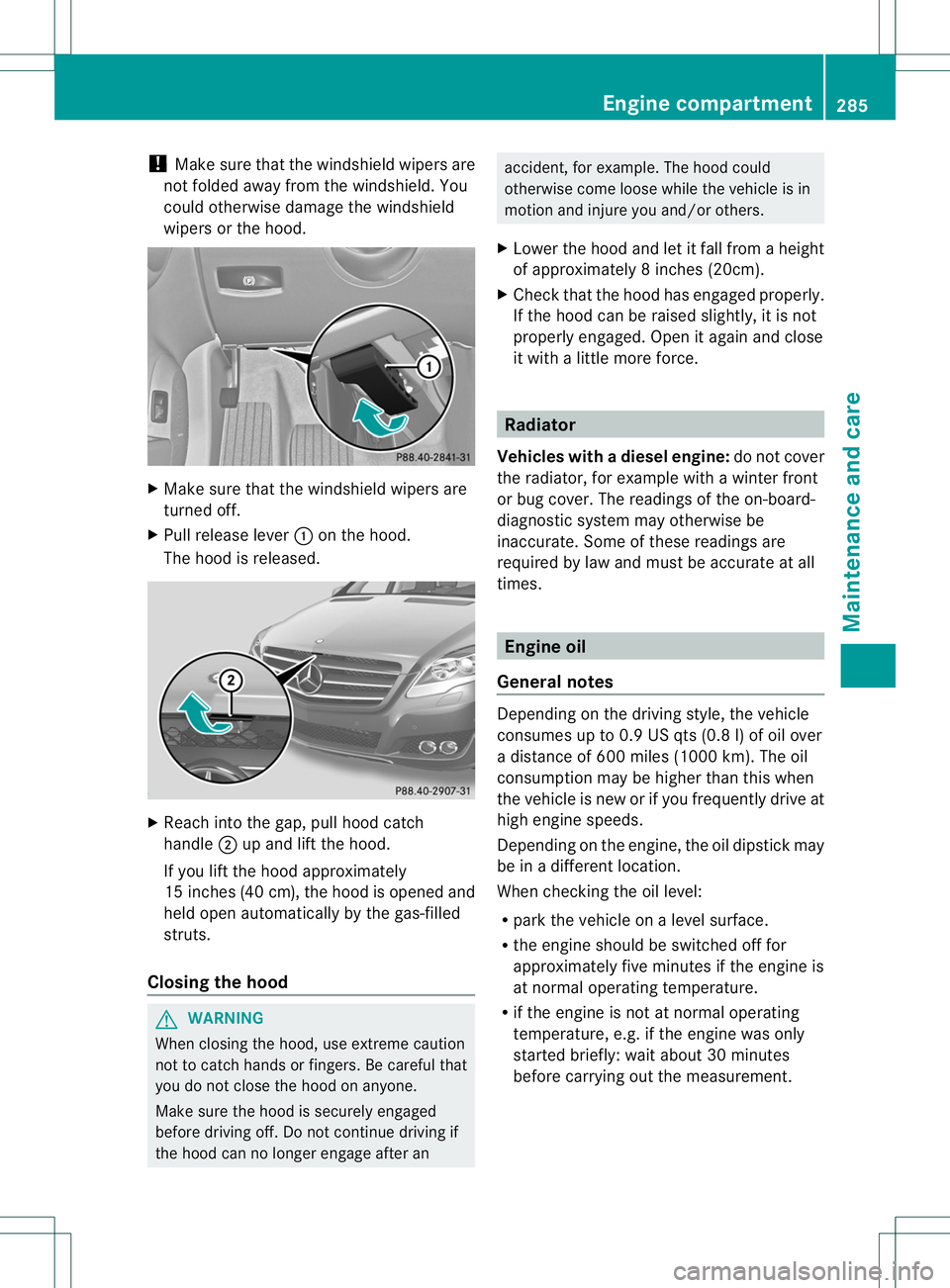
!
Make sure that the windshieldw ipers are
not folded away fro mthe windshield. You
could otherwise damage the windshield
wipers or the hood. X
Make sure that the windshield wipers are
turned off.
X Pull release lever :on the hood.
The hood is released. X
Reach into the gap, pull hood catch
handle ;up and lift the hood.
If you lift the hood approximately
15 inches (40c m), the hood is opened and
held open automatically by the gas-filled
struts.
Closing the hood G
WARNING
When closing the hood, use extreme caution
not to catch hands or fingers. Be careful that
you do not close the hood on anyone.
Make sure the hood is securely engaged
before driving off. Do not continue driving if
the hood can no longer engage after an accident, for example. The hood could
otherwise come loose while the vehicle is in
motion and injure you and/oro
thers.
X Lower the hood and le titfall from a height
of approximately 8inche s(20cm).
X Check that the hood has engaged properly.
If the hood can be raised slightly, it is not
properly engaged. Open it again and close
it with a little more force. Radiator
Vehicles with adiesel engine: do not cover
the radiator, for example with a winter front
or bug cover. The reading softhe on-board-
diagnostic system may otherwise be
inaccurate. Some of these readings are
required by law and must be accurate at all
times. Engine oil
General notes Depending on the driving style, the vehicle
consumes up to 0.9 US qts (0.8 l) of oil over
a distance of 600 miles (1000 km). The oil
consumption may be higher than this when
the vehicle is new or if you frequently drive at
high engine speeds.
Depending on the engine, the oil dipstick may
be in a different location.
When checking the oil level:
R
park the vehicle on a level surface.
R the engine should be switched off for
approximately five minutes if the engine is
at normal operating temperature.
R if the engine is not at normal operating
temperature, e.g. if the engine was only
started briefly: wait about 30 minutes
before carrying out the measurement. Engine compartment
285Maintenance and care Z